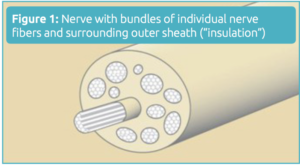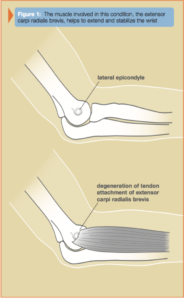Price: $4,200.00
CPT Code: 64718
 Nerve Injuries
Nerve Injuries
Nerves are the body’s “telephone wiring” system that car- ries messages between the brain and the rest of the body. Some nerves carry messages from the brain to muscles to make the body move. Other nerves carry messages
about pain, pressure, or temperature from the body to the brain. Many small bers are bundled inside each nerve to carry the messages. There is an outer layer that insulates and protects the nerves (Figure 1). Sometimes, nerves can be damaged.
Causes
Nerves can be damaged by too much pressure, by stretch- ing, or by a cut. Carpal tunnel syndrome is an example of a problem that arises from too much pressure on the median nerve in the hand. Carpal tunnel syndrome can injure the median nerve slowly over time or, in the case of trauma to the area, it can occur much more quickly. A cut to the nerve can cause it to no longer transmit sig- nals, because the signal cannot jump through a gap in the nerve. Stretch injuries to the nerve can range from mild, temporary injury to a more severe, permanent injury. The extent of the injury depends on the amount of stretch.
Signs and Symptoms
The signs and symptoms of nerve injuries can be di erent depending on the nerve injured, the type of injury, and the severity of the injury. Some may include:
• Numbness: Some nerves only transmit sensation, so a nerve injury to these nerves would cause some amount of numbness.
• Weakness: In addition to sensory nerves, some nerves give you the ability to move, and other nerves do both of these things. Injury to nerves that carry motor signals causes some amount of weakness.
• Pain: This is frequently a symptom after nerve injury. The pain present after a nerve injury can be anywhere along the course of the nerve, but it is typically at the injury site.
Symptoms of nerve injury may be intermittent, if the injury repeats itself; or they may be constant, if the injury is severe enough. There are many other signs of nerve injury: muscles that get smaller, color change in the skin, and changes to the amount of sweat in certain areas. An example of a nerve injury that can recur is carpal tun- nel syndrome. Carpal tunnel syndrome occurs when the median nerve has too much pressure on it as it crosses the wrist. The symptoms of numbness in the hand, pain in the hand, pain in the wrist, pain in the forearm, or weakness (particularly in the thumb) can be present. The symp- toms of carpal tunnel syndrome can be intermittent or, if severe enough, can occur all of the time.
Treatment
Some nerve injuries can get better without help, but some injuries need to be repaired.
• Mild injuries to the nerve: The nerve can repair itself, either within minutes or after a number of weeks. During this time, messages between the brain and body can be altered. Supportive treat- ment often helps, but in some cases surgery is needed.
• Broken nerve bers or more severe injuries: The nerves can grow back to their muscle or skin areas, but this process can take several months, and the messages between the brain and body will stop un- til the nerves grow. Treatment may be supportive care, but surgery may be needed depending on the type of injury.
• Cut nerve: When both the nerve outer wrap and inner bers of the nerve are cut, surgery is typically needed to allow the nerve to heal correctly.
In surgery, the nerve ends may be sewn back together. The inner nerve bers will need to grow back to their muscle or skin areas to regain function.
Recovery
The nerve bers grow slowly and, in ideal conditions, may grow about one inch every month after a nerve is sewn back together in surgery. It can take many months for the nerve to finish growing after an injury depending on many factors including the length that the nerve that needs to grow. It can also take this long for muscles to work well again. There might be numbness, pain or a “pins and needles” feeling during the healing period. Physical therapy is sometimes needed after a nerve injury. Results during recovery after nerve injury can depend on your age and health, the type of nerve injury, and the injured body part.
Lateral Epicondylitis (Tennis Elbow)
What is it?
Lateral epicondylitis, commonly known as tennis elbow, is a painful condition involving the tendons that attach to the bone on the outside (lateral) part of the elbow. Tendons anchor the muscle to bone. The muscle involved in this condition, the extensor carpi radialis brevis, helps to extend and stabilize the wrist (see Figure 1). With lateral epicondylitis, there is degeneration of the tendon’s attachment, weakening the anchor site and placing greater stress on the area. This can then lead to pain associated with activities in which this muscle is active, such as lifting, gripping, and/or grasping. Sports such as tennis are commonly associated with this, but the problem can occur with many different types of activities, athletic and otherwise.
What causes it?
Overuse – The cause can be both non-work and work related. An activity that places stress on the tendon attachments, through stress on the extensor muscle-tendon unit, increases the strain on the tendon. These stresses can be from holding too large a racquet grip or from “repetitive” gripping and grasping activities, i.e. meat-cutting, plumbing, painting, weaving, etc.
Trauma – A direct blow to the elbow may result in swelling of the tendon that can lead to degeneration. A sudden extreme action, force, or activity could also injure the tendon.
Who gets it?
The most common age group that this condition affects is between 30 to 50 years old, but it may occur in younger and older age groups, and in both men and women.
Signs and symptoms
Pain is the primary reason for patients to seek medical evaluation. The pain is located over the outside aspect of the elbow, over the bone region known as the lateral epicondyle. This area becomes tender to touch. Pain is also produced by any activity which places stress on the tendon, such as gripping or lifting. With activity, the pain usually starts at the elbow and may travel down the forearm to the hand. Occasionally, any motion of the elbow can be painful.
Treatment
Conservative (non-surgical)
Activity modification – Initially, the activity causing the condition should be limited. Limiting the aggravating activity, not total rest, is recommended. Modifying grips or techniques, such as use of a different size racket and/or use of 2-handed backhands in tennis, may relieve the problem.
Medication – anti-inflammatory medications may help alleviate the pain.
Brace – a tennis elbow brace, a band worn over the muscle of the forearm, just below the elbow, can reduce the tension on the tendon and allow it to heal.
Physical Therapy may be helpful, providing stretching and/or strengthening exercises. Modalities such as ultrasound or heat treatments may be helpful.
Steroid injections – A steroid is a strong anti-inflammatory medication that can be injected into the area. No more than (3) injections should be given.
Shockwave treatment – A new type of treatment, available in the office setting, has shown some success in 50–60% of patients. This is a shock wave delivered to the affected area around the elbow, which can be used as a last resort prior to the consideration of surgery.
Surgery
Surgery is only considered when the pain is incapacitating and has not responded to conservative care, and symptoms have lasted more than six months. Surgery involves removing the diseased, degenerated tendon tissue. Two surgical approaches are available; traditional open surgery (incision), and arthroscopy—a procedure performed with instruments inserted into the joint through small incisions. Both options are performed in the outpatient setting.
Recovery
Recovery from surgery includes physical therapy to regain motion of the arm. A strengthening program will be necessary in order to return to prior activities. Recovery can be expected to take 4–6 months.
© 2015 American Society for Surgery of the Hand
